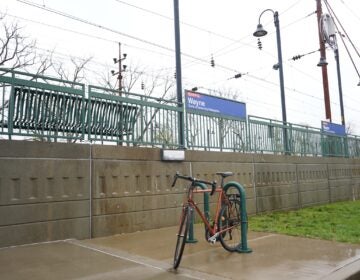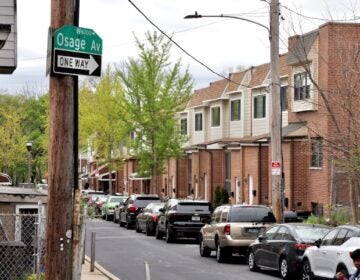Philly electric bills go up June 1. Advocates say more renewables are a solution
May 28, 2025
Have a question about Philly’s neighborhoods or the systems that shape them? PlanPhilly reporters want to hear from you! Ask us a question or send us a story idea you think we should cover.
With electricity bills set to rise for Pennsylvania, New Jersey and Delaware customers next month, clean energy advocates are demanding the regional electric grid operator allow new renewable energy sources to connect to the grid faster.
Activists rallied at the PJM Interconnection headquarters in Audubon, Pennsylvania on Wednesday, saying the looming increases are a result of the grid operator’s sluggishness with connecting new green energy sources in favor of fossil fuel projects.
“Our rates are going up, and it’s PJM’s fault because they are failing to allow new clean energy to come online,” said Elowyn Corby, Mid-Atlantic regional director for Vote Solar, a nonprofit that advocates for policies that would enable a transition to clean energy. “They’re not doing what they should to keep consumer interests and ratepayer interests at heart.”
The average household’s PECO bill is set to rise around $8 a month June 1, in part due to a supply and demand crunch on the regional grid.
In response to Wednesday’s protest, PJM, which runs the electric grid across Washington D.C. and part or all of 13 states, including all of Pennsylvania, Delaware and New Jersey, pointed the finger back at the climate activists.
“Those organizations who visited today have actively worked to push critical power resources off of the system, raising prices and threatening reliability, and now they are protesting the results of their own actions,” said PJM spokesperson Jeff Shields in an emailed statement. “We have been warning of this imbalance between supply and demand for some years now and continue to work proactively to maximize our available electricity for the benefit of consumers. Today’s protest is simply an exercise in blame shifting.”
Anjuli Ramos-Busot, director of the NJ Sierra Club — one of the organizations behind Wednesday’s rally — said her organization does advocate for the shutdown of “very dirty, inefficient and costly coal-fired power plants,” such as two outside Baltimore that PJM fought to keep open.
“Keeping these power plants … is costing more money [for the] ratepayers, as well as [causing] more pollution,” Ramos-Busot said.

Tight electricity supply, rising demand
PJM has a massive backlog of projects that have applied to connect to the grid, most of them wind, solar or battery storage. Meanwhile, retirements of older power plants and rising energy demand driven by data centers threaten to cause a shortfall in electricity supply in the coming years.
A process PJM uses to guarantee future electricity supply, called a capacity auction, resulted in record prices last year that were several times higher than in 2023.
PJM says it’s a simple issue of supply and demand.
PJM officials say demand for power is increasing due to data centers, electrification of vehicles and heating systems and “a resurgence in U.S. manufacturing.”
But the grid operator says demand is not growing fast enough to meet it, due to delays in construction of new projects that have been approved for interconnection, market reforms that better estimate the impact of extreme weather on demand and the reliability of energy sources — a factor environmental advocates call “fossil fuel unreliability” — and decarbonization policies PJM says have forced the retirement of older fossil fuel power plants.
In testimony before two state Senate committees this spring, Pennsylvania Public Utility Commission Chair Stephen DeFrank also blamed “the growing use of intermittent renewable energy resources, which require a balanced mix of capacity solutions to maintain reliability.”
But renewables, mainly wind and hydropower, currently generate just 5% of power in the PJM grid, with solar accounting for less than 1%. The leading source of power generation in the regional grid is gas, followed by nuclear, then coal.
Advocates say the grid needs to quickly transition toward renewables and away from fossil fuels, because of their role in driving climate change.
“The climate emergency requires that we cut fossil fuels from our power grid and from our homes,” said Patrick Houston, campaign manager for the housing and climate advocacy coalition HERE 4 Climate Justice, who spoke at Wednesday’s rally. “We need energy-efficient homes and we need to move our power grid off dirty fossil fuels to renewables.”
Grid costs raise household electricity bills
The capacity costs that result from PJM’s auctions are passed along to consumers through their utility bills.
PECO customers will see a 10% increase in bills phased in over two years as a result of the higher capacity costs. The average residential customer’s bill will go up roughly $8 starting June 1, which reflects both the increased capacity costs and increased costs of the power itself, driven by higher demand, said spokesperson Candice Womer.
The increased capacity costs will continue to phase in with bill increases for PECO customers starting December 2025, June 2026 and December 2026, Womer said.
“This is going to make life harder for all the households across our state and our region who are living paycheck to paycheck,” Rev. Nathaniel Mahlberg, pastor at the United Church of Christ at Valley Forge and a member of POWER Interfaith, said at Wednesday’s rally.
Early this year, after threatening to pull Pennsylvania from the regional grid system, Gov. Josh Shapiro’s administration reached an agreement with PJM to cap the price of future capacity auctions at a price higher than the one reached last year.
The governor’s office said the agreement will likely save Pennsylvania ratepayers around $4 billion between 2026 and 2028.
PJM is reforming its interconnection process, but advocates say not fast enough
PJM has begun changing its interconnection process to work through the backlog faster. In recent years the grid operator has switched from a first-come, first-served system to a “first-ready, first-served” system for evaluating applications, a move meant to weed out speculative projects and prioritize those that will be built fastest. PJM also started evaluating projects in “clusters,” rather than individually.
“We don’t underestimate the impact of higher electricity costs to consumers that are being felt within PJM and across the country,” Shields said. “That’s why we continue to work with all our stakeholders to alleviate the supply and demand imbalance that is driving those costs through multiple successful proposals to maximize available generation while bringing new generation online faster.”
Shields pointed to a one-time initiative that selected 51 “shovel-ready” projects the grid operator says will improve reliability. They consist of gas, battery storage, nuclear and coal generation, and will be online by 2031. Under PJM’s system of evaluating the reliability of energy sources, sources like nuclear, diesel and coal score the highest, followed by gas, storage and offshore wind. Solar scores the lowest.
PJM is also working with Google and Tapestry to use artificial intelligence to “manage and optimize” the grid operator’s interconnection process.
At Wednesday’s rally, Ramos-Busot said the grid operator is not doing enough to speed up clean energy interconnection approvals.
“They are not formalizing or improving their interconnection evaluations fast enough in order to manage what is needed right now and into the future,” Ramos-Busot said. “If PJM were to connect fast enough the projects that are in the queue, we wouldn’t be in this situation.”
PJM welcomes all resources to the grid, Shields said. But in addition to renewables, the grid will continue to need conventional energy sources, such as nuclear, coal and gas, to “provide essential reliability services,” he said.
“The more supply we have, the more it will serve to drive down the cost of capacity to consumers,” Shields said.
Roughly 63,000 megawatts of power generation projects, over 90% of which are solar, wind or battery, are waiting to be cleared from PJM’s interconnection queue over the next two years. About 47,000 megawatts worth of projects have recently cleared the queue and are under construction or waiting to start construction, Shields said.

Get daily updates from WHYY News!
WHYY is your source for fact-based, in-depth journalism and information. As a nonprofit organization, we rely on financial support from readers like you. Please give today.
Search
RECENT PRESS RELEASES
Related Post










